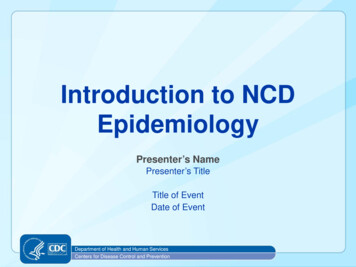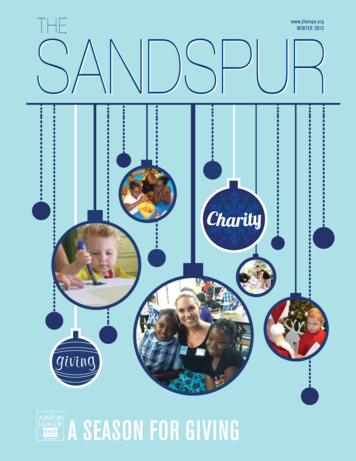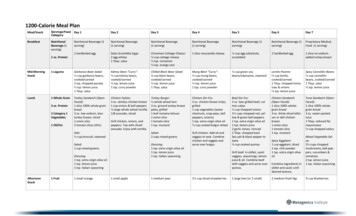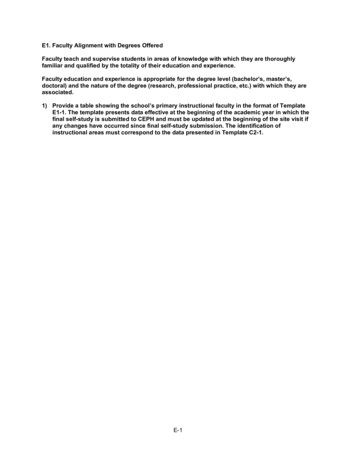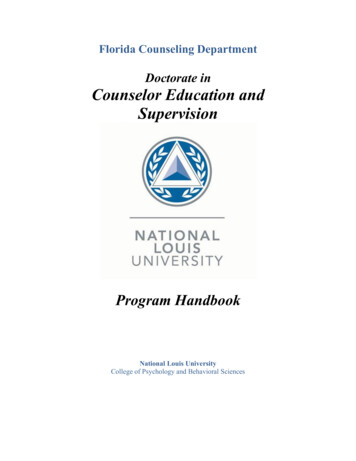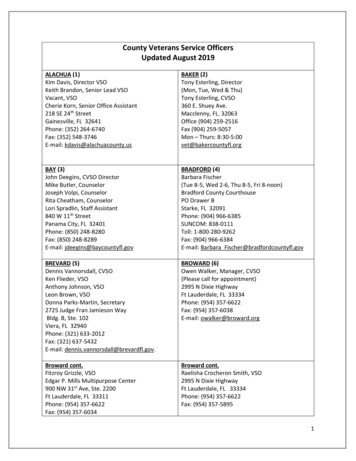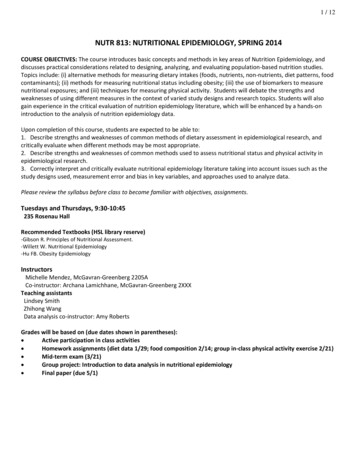
Transcription
1 / 12NUTR 813: NUTRITIONAL EPIDEMIOLOGY, SPRING 2014COURSE OBJECTIVES: The course introduces basic concepts and methods in key areas of Nutrition Epidemiology, anddiscusses practical considerations related to designing, analyzing, and evaluating population-based nutrition studies.Topics include: (i) alternative methods for measuring dietary intakes (foods, nutrients, non-nutrients, diet patterns, foodcontaminants); (ii) methods for measuring nutritional status including obesity; (iii) the use of biomarkers to measurenutritional exposures; and (iii) techniques for measuring physical activity. Students will debate the strengths andweaknesses of using different measures in the context of varied study designs and research topics. Students will alsogain experience in the critical evaluation of nutrition epidemiology literature, which will be enhanced by a hands-onintroduction to the analysis of nutrition epidemiology data.Upon completion of this course, students are expected to be able to:1. Describe strengths and weaknesses of common methods of dietary assessment in epidemiological research, andcritically evaluate when different methods may be most appropriate.2. Describe strengths and weaknesses of common methods used to assess nutritional status and physical activity inepidemiological research.3. Correctly interpret and critically evaluate nutritional epidemiology literature taking into account issues such as thestudy designs used, measurement error and bias in key variables, and approaches used to analyze data.Please review the syllabus before class to become familiar with objectives, assignments.Tuesdays and Thursdays, 9:30-10:45235 Rosenau HallRecommended Textbooks (HSL library reserve)-Gibson R. Principles of Nutritional Assessment.-Willett W. Nutritional Epidemiology-Hu FB. Obesity EpidemiologyInstructorsMichelle Mendez, McGavran-Greenberg 2205ACo-instructor: Archana Lamichhane, McGavran-Greenberg 2XXXTeaching assistantsLindsey SmithZhihong WangData analysis co-instructor: Amy RobertsGrades will be based on (due dates shown in parentheses): Active participation in class activities Homework assignments (diet data 1/29; food composition 2/14; group in-class physical activity exercise 2/21) Mid-term exam (3/21) Group project: Introduction to data analysis in nutritional epidemiology Final paper (due 5/1)
2 / 12DETAILED SYLLABUS WITH READINGSEPIDEMIOLOGY CONCEPTS AND METHODS REVIEW SESSION: STRONGLY RECOMMENDEDTentatively: Thursday Jan 23 [final time and location TBA]Learning objectives: Review basic study designs, interpretation of different measures of association, potential sources of bias (e.g.selection, information bias such as recall bias, confounding), and criteria for causal relationships.The main objective is to prepare students with limited exposure to epidemiology for the basic epidemiology methods and concepts.There will be a short quiz based on the material covered.1: Thursday Jan 9[1a] Introduction to nutritional epidemiology Overview of the scope of nutrition epidemiology research and syllabusreview exercise [MM].[1b] Case study exercise: Adapting a dietary intake assessment tool to meet study aims [MM]--------Learning objectives: Course overview. Introduce objectives and challenges in nutritional epidemiology research, noting the broadscope of the field, and describing challenges involved in measuring the main variables of interest (diet, activity, nutritional status).Required readings: Please review course syllabus before classPART 1 (MEASURES): ASSESSMENT OF FOOD INTAKES2: Tuesday Jan 14[2a] Dietary assessment overview: Review the main methods for dietary assessment, focusing on strengths andlimitations. Brief review of potential goals of dietary assessment (e.g. estimate intakes of various dietary factors toassess compliance with guidelines, assess nutrient status, evaluate a policy or intervention program, or evaluaterelationships with health outcome). [30 min MM or AL][2b] Small group brainstorming [35 min]: The participant perspective on dietary assessment—how might factors such astime required, cognitive burden, and social desirability affect intake reporting? Small groups will develop a list ofimportant pros and cons of alternative methods to collect usual intake data of major food groups in light of thechallenges respondents face. Keep in mind personal experiences from homework assignment of completing a diet recall,diet record, FFQ, and a brief fruit and vegetable screener. Readings: Be prepared to integrate/discuss Thompson et al(especially Table 1) and Scagliusi et al (especially paragraph 3 of results and Table 3) in developing your pros and cons.--------Learning objectives: Further raise awareness of how issues such as the structure of alternative dietary assessment methods andparticipant characteristics may influence reported intakes and data quality/validity.Required activities:-Partial completion of a 24-h recall, a diet record, an FFQ, and a fruit and vegetable screener. Instruments can be found at:(i) ASA24 recall: http://asa24demo.westat.com/ [input at least 2 meals];(ii) Diet record/ diary: In excel or word using format as esity/lose wt/diary.htm [input at least 1 large meal, notingingredients in as much detail as possible (oils, condiments, etc.)];(iii) Food frequency questionnaire [the NCI’s Diet History Questionnaire]: e 2&method 1 [complete at least 50%];(iv) F&V screener: eg/allday.pdf [complete in full].Required readings:-Thompson FE, Subar A F. Dietary assessment methodology. Chapter 1. NCI Assessing Dietary pson subar dietary assessment methodology.pdf-Scagliusi FB et al. Selective underreporting of energy intake in women: magnitude, determinants, and effect of training. J Am DietAssoc. 2003 Oct;103(10):1306-13.Suggested readings/resources for for future reference:-Hu textbook, pp 84-88-Willett textbook, pp. 4 to 148
3 / 12Begin homework assignment 1 (due Jan 21)—dietary assessment comparisons: Students will review and compare reported intakesof energy and selected nutrients (dietary fat, fiber) obtained using 24-h recalls, diet records and an FFQ.3: Thursday Jan 16[3a] Strengths, weaknesses and validity of dietary assessment methods: Typical sources of error and bias in estimatesof dietary intake including variation; approaches for validating intakes [30 min MM or AL].[3b] Small group case-study: dietary assessment consulting [15 min small groups/25 min class feedback to groups]The researcher perspective on dietary assessment. You are asked to advise a research group on appropriate dietaryassessment methods for one of the following studies: (a) a randomized weight loss intervention in overweight and obeseadults involving reduced sedentarism and dietary behavior changes (e.g. increased fruit and vegetable intakes); (b) acase-control study on dietary risk factors (e.g. fruit/vegetable or cereal fiber; probiotics) for irritable bowel syndrome,believed to develop over many years, and (c) a prospective study which will explore diet quality (e.g. fruit and vegintake) and incident obesity in a small multi-ethnic cohort of 9-10y old children, and (d) a prospective cohort study onmaternal diet during pregnancy and infant neurodevelopment at one year of age, with a particular interest in fishconsumption. As limited resources are available for collecting these data, the researchers have asked about thepossibility of using low-cost approaches such as web-based methods, or brief tools. What approach will you suggest theyuse to collect dietary data? Justify your recommendation. Readings: Keep in mind to mention in your justification anyrelevant findings from Bingham et al (esp Table 4 and Figure 1), Mendez et al (esp Figure 2 and Table 3), and MartínezGonzález et al (e.g. Table 3).--------Learning objectives: Provide insights on how the choice of dietary assessment method depends on study goals, as instruments mayinfluence not only reported intakes, but also associations between intakes and health outcomes.Required readings:-Bingham S et al. Associations between dietary methods and biomarkers, and between fruits and vegetables and risk of ischaemicheart disease, in the EPIC Norfolk Cohort Study. Int J Epidemiol. 2008 Oct;37(5):978-87.-Mendez MA et al. Under- and overreporting of energy is related to obesity, lifestyle factors and food group intakes in Jamaicanadults. Public Health Nutr. 2004;7(1):9-19.-Martínez-González MA et al. A 14-Item Mediterranean Diet Assessment Tool and Obesity Indexes among High-Risk Subjects: ThePREDIMED Trial. PLoS One. 2012;7(8):e43134Suggested readings/resources for future reference:-Sempos CT et al. Effects of intraindividual and interindividual variation in repeated dietary records. Am J Epidemiol. 1985Jan;121(1):120-30.-Greene GW et al. Correspondence of the NCI Fruit and Vegetable Screener to repeat 24-H recalls and serum carotenoids inbehavioral intervention trials. J Nutr. 2008 Jan;138(1):200S-204S-Ma Y et al. Seasonal variation in food intake, physical activity, and body weight in a predominantly overweight population. Eur J ClinNutr. 2006 Apr;60(4):519-28.4: Tuesday Jan 21[4a] Case study: conducting a critical review of diet-health outcome associations [30 min MM].[4b] Small group case study discussion [20 min small groups/20 min class discussion]: Four small groups will each designa new study to increase knowledge on the topic presented, taking into account limitations of existing literaturepresented in class. Proposed projects will be presented to the class, highlighting how the design they propose addressesweaknesses of earlier studies to contribute new knowledge. Class discussion will focus on common design ideas acrossgroups, as well as strengths and weaknesses of any differences in proposed designs.--------Learning objectives: Introduction to evaluating the literature: the potential impact of factors including (among others) definitions ofintake variables, ranges of intake or exposure, and data analysis approaches on individual study results, and implications forevaluating a body of literature. Define different types of reviews: non-systematic eg state-of-the-art, systematic review and metaanalyses.Required readings: NoneSuggested readings: NoneTurn in homework assignment 1: Comparison of data from alternative dietary assessment methods
4 / 125: Thursday Jan 23[5a] Dietary patterns: Rationale for studying dietary patterns. Methods for developing and analyzing patterns thataccount for health effects of multiple dietary factors in dietary patterns [30 minute lecture AL or MM][5b] Informal debate: The class will break into two groups who will debate the pros and cons of assessing dietarypatterns using either (i) an a priori method (eg Mediterranean diet scores, Healthy Eating Index) or (ii) data-drivenmethods (e.g. factor or cluster analysis). [10 min brainstorming, 20 min debate]. -Readings: In your discussions, build oninformation from Reedy et al Table 1 (overview of interpreting different types of patterns); Fung et al methods section(especially methods section on construction of alternative a priori indices), and Varraso et al (results table illustratingdistribution of food intakes across factor scores).--------Learning objectives: To discuss how synergies in health effects of multiple foods/nutrients can be potentially relevant for healthoutcomes. To raise awareness of the difference questions being addressed by research applying a priori vs. data-driven methods fordeveloping dietary patterns. To discuss the relevance of exploring diet-disease relationships at multiple levels, including individualnutrients and foods as well as overall patterns.Required readings:-Reedy J, Wirfält E, Flood A, Mitrou PN, Krebs-Smith SM, Kipnis V, Midthune D, Leitzmann M, Hollenbeck A, Schatzkin A, Subar AF.Comparing 3 dietary pattern methods--cluster analysis, factor analysis, and index analysis--With colorectal cancer risk: The NIH-AARPDiet and Health Study. Am J Epidemiol. 2010 Feb 15;171(4):479-87.-Fung TT, McCullough ML, Newby PK, Manson JE, Meigs JB, Rifai N, Willett WC, Hu FB. Diet-quality scores and plasma concentrationsof markers of inflammation and endothelial dysfunction. Am J Clin Nutr. 2005 Jul;82(1):163-73.-Varraso R, Fung TT, Barr RG, Hu FB, Willett W, Camargo CA Jr. Prospective study of dietary patterns and chronic obstructivepulmonary disease among US women. Am J Clin Nutr. 2007 Aug;86(2):488-95.Suggested readings/resources for future reference:-Hu FB. Dietary pattern analysis: a new direction in nutritional epidemiology 2002-Mendez MA, Popkin BM, Jakszyn P et al. Adherence to a Mediterranean diet is associated with reduced 3-year incidence of obesity.J Nutr. 2006 Nov;136(11):2934-8. See especially: Methods section paragraph on constructing diet score and Figure 1.PART 2 (MEASURES): ASSESSMENT OF NUTRITIONAL STATUS6: Tuesday Jan 28Short epi methods quiz in class today[6] Assessment of nutritional status, part 1 [60 min MM or AL; 15 min discussion] Use and interpretation ofanthropometric and more direct measures of body composition/adiposity; sources of error and bias; relationshipsbetween anthropometry and measures of adiposity; use of multiple measures of obesity. Readings: Be prepared todiscuss table 4 and Figure 2 of Janssen et al.--------Learning objectives: Highlight sources of error and bias in anthropometric as well as direct measures of obesity (e.g. inter-observervariability, bioelectric impedance prediction equations), differences in interpretation, and strengths as well as limitations of variousmeasures.Required readings (for discussion in class):-Janssen I, Mark AE. Separate and combined influence of body mass index and waist circumference on arthritis and kneeosteoarthritis. Int J Obes (Lond). 2006 Aug;30(8):1223-8. Be prepared to discuss Table 4 and Figure 2.-Cole TJ, Bellizzi MC, Flegal KM, Dietz WH. Establishing a standard definition for child overweight and obesity worldwide:international survey. BMJ. 2000 May 6;320(7244):1240-3.Suggested readings/resources for future reference:-Ashwell M, Gunn P, Gibson S. Waist-to-height ratio is a better screening tool than waist circumference and BMI for adultcardiometabolic risk factors: systematic review and meta-analysis. Obes Rev. 2012 Mar;13(3):275-86-Shah NR, Braverman ER. Measuring adiposity in patients: the utility of body mass index (BMI), percent body fat, and leptin. PLoSOne. 2012;7(4):e33308.
5 / 127: Thursday Jan 30[7a] Assessment of nutritional status, part 2: Obesity in global and diverse populations [30 min MM or AL][7b] Small group debates on two topics: 1) Should different BMI cutpoints be used for different ethnic groups whencomparing adult overweight and obesity across the globe? And 2) Should a single waist circumference criterion be usedfor all US children and adolescents or should ethnic group specific criterion be utilized? Readings: Be prepared to citethe assigned readings to support the side of the debate to which you are assigned.--------Learning objectives: Highlight variable associations between direct measures of adiposity and anthropometry across populations.Required readings (for discussion in class):-Flegal KM, Ogden CL, Yanovski JA, Freedman DS, Shepherd JA, Graubard BI, Borrud LG. High adiposity and high body mass index-forage in US children and adolescents overall and by race-ethnic group. Am J Clin Nutr. 2010 Apr;91(4):1020-6. (See especially figure 3)-Yajnik CS, Yudkin JS. The Y-Y paradox. Lancet. 2004 Jan 10;363(9403):163.-WHO expert consultation, Appropriate body-mass index for Asian populations and its implications for policy and interventionstrategies. Lancet. 2004 Jan 10; 363: 157-63.-Messiah SE et al. Ethnic group differences in waist circumference percentiles among U.S. children and adolescents: estimates fromthe 1999-2008 National Health and Nutrition Examination Surveys. Metab Syndr Relat Disord. 2011 Aug;9(4):297-303Suggested readings/resources for future reference:-Freedman DS, Ogden CL, Berenson GS, Horlick M. Body mass index and body fatness in childhood. Curr Opin Clin Nutr Metab Care.2005 Nov;8(6):618-23.PART 3 (MEASURES): ASSESSING INTAKES OF NUTRIENTS, NON-NUTRIENTS8: Tuesday Feb 4[8a] Development and use of food composition tables (nutrients and non-nutrients)-Part 1: Overview of major food composition resources, challenges in linking intake data with FCTs, and the range ofdietary factors of interest to estimate using FCTs (n-3s, PAHs, glycemic index, antioxidant capacity) [30 min MM].-Part 2: Methods being used to improve the precision of FCT data by the UNC Food Research Program (FRP) [40 min]. Inclass exercise by FRP.--------Learning objectives: Introduce the challenge of compiling sufficiently valid food composition data. Review major sources of foodcomposition data and potential discuss sources of error, including variability in nutrient content and missing values.Required readings:-Gibson R. Principles of Nutritional Assessment, Chapter 4, pp 65 through 69.-Pennington JA, Stumbo PJ, Murphy SP, McNutt SW, Eldridge AL, McCabe-Sellers BJ, Chenard CA. Food composition data: thefoundation of dietetic practice and research. J Am Diet Assoc. 2007 Dec;107(12):2105-13.Suggested readings/resources for future reference:-Garcia V, Rona RJ, Chinn S. Effect of the choice of food composition table on nutrient estimates: a comparison between the Britishand American (Chilean) tables. Public Health Nutr. 2004 Jun;7(4):577-83.-Jakszyn P, Agudo A, Ibáñez R, García-Closas R, Pera G, Amiano P, González CA. Development of a food database of nitrosamines,heterocyclic amines, and polycyclic aromatic hydrocarbons. J Nutr. 2004 Aug;134(8):2011-4.-Directory of international food composition data: http://www.fao.org/infoods/directory en.stm-Composition of Foods Raw, Processed, Prepared. USDA National Nutrient Database for Standard Reference, Release 4500/Data/SR25/sr25 doc.pdfBegin homework assignment 2 (due Feb 14): Short exercise on adapting food composition data for use in a global context.9: Thursday Feb 6[9a] Biomarkers in nutritional epidemiology: Challenges and considerations in the use of biomarkers as proxies or goldstandards of dietary intakes, including variability related to within-person/daily changes, seasonal effects, genetic andother influences on metabolism, and factors that may impact bioavailability and turnover. [30-40 min MM or AL]Readings: Be prepared to discuss Table 4 of Prentice et al, which shows associations between energy intake anddifferent types of cancer before and after biomarker calibration.
6 / 12--------Learning objectives: Review biomarker media reflecting dietary intakes (blood, urine, adipose tissue, nails, hair), the interpretationof different types of biomarkers (concentration, recovery, replacement), and factors that influence biomarker variability. Describethe use of biomarkers to validate, calibrate and substitute for intake estimates, and limitations such as the absence of reliablemarkers for many diet components.Required readings:-Hu, Obesity Epidemiology, pp 88-100-Prentice RL, Shaw PA, Bingham SA et al. Biomarker-calibrated energy and protein consumption and increased cancer risk amongpostmenopausal women Am J Epidemiol. 2009 Apr 15;169(8):977-89.Suggested readings/resources for future reference:-Crews H, Alink G, Andersen R, Braesco V et al. A critical assessment of some biomarker approaches linked with dietary intake. Br JNutr. 2001 Aug;86 Suppl 1:S5-35-Potischman N. Biologic and methodologic issues for nutritional biomarkers. J Nutr. 2003 Mar;133 Suppl 3:875S-880S.-Shai I, Rosner BA, Shahar DR, Vardi H, Azrad AB, Kanfi A, Schwarzfuchs D, Fraser D; DEARR study. Dietary evaluation and attenuationof relative risk: multiple comparisons between blood and urinary biomarkers, food frequency, and 24-hour recall questionnaires: theDEARR study. J Nutr. 2005 Mar;135(3):573-9.-Dehghan M, Akhtar-Danesh N, McMillan CR, Thabane L. Is plasma vitamin C an appropriate biomarker of vitamin C intake? Asystematic review and meta-analysis. Nutr J. 2007 Nov 13;6:41.PART 4 (MEASURES): ASSESSMENT OF PHYSICAL ACTIVITY (ENERGY EXPENDITURE)10: Tuesday Feb 11[10a] Physical activity assessment and analysis: Critical review of subjective and objective methods for measuringdifferent types of physical activity and sedentarism [40 min MM].[10b] Start group homework exercise (due Feb 19) on the challenges of physical activity assessment using self-reports.--------Learning objectives: Review of main methods for assessing self-reported and objective measures of physical activity and inactivity(recalls, records and other questionnaires), as well as objective measures activity (pedometers, accelerometers, heart ratemonitoring, doubly-labeled water). Critical assessment of the strengths and limitations of alternative approaches.Required readings:-Lagerros YT, Lagiou P. Assessment of physical activity and energy expenditure in epidemiological research of chronic diseases. Eur JEpidemiol. 2007;22(6):353-62.Suggested readings:-Ainsworth BE, Haskell WL et al. Compendium of physical activities: an update of activity codes and MET intensities. Med Sci SportsExerc. 2000;32(9 Suppl):S498-504.-Welk GJ, Corbin CB, Dale D. Measurement issues in the assessment of physical activity in children. Res Q Exerc Sport. 2000;71(2Suppl):S59-73.-Wareham NJ, van Sluijs EM, Ekelund U. Physical activity and obesity prevention: a review of the current evidence. Proc Nutr Soc.2005;64(2):229-47.Homework assignment: Become familiar with accessing the statistical analysis software STATA via the UNC virtual computing lab,which we will begin to use in the next class. https://vcl.unc.edu/index.php?mode selectauthBegin group homework assignment 3 (due Feb 21): Students will begin in class a short exercise in which they will evaluate theability of alternative physical activity questionnaires to rank subjects with respect to activity-related energy expenditure, comparedwith more detailed data from an activity diary.PART 5 (DATA ANALYSIS): ANALYZING DATA TO ESTIMATE ASSOCIATIONS11: Thursday Feb 13[11a] Introduction to data analysis issues: Integrating hypothesis generation, design and analysis [40 min MM].[11b] Begin data analysis lab project, part 1 (DUE FEB 27): Overview of STATA commands for descriptive analyses.Introduction to descriptive analysis: begin estimating food group intakes from FFQ data, and estimating the prevalenceof child overweight [20 minutes, AR with LS and ZW].
7 / 12--------Learning objectives: Developing study hypotheses and specific aims; beginning to data analyses.Required readings: NoneSuggested readings:- Wang Y, Beydoun MA. Meat consumption is associated with obesity and central obesity among US adults. Int J Obes (Lond). 2009Jun;33(6):621-8. Epub 2009 Mar 24.Turn in homework assignment 2: adapting food composition data for use in a global context.12: Tuesday Feb 18[12a] Data analysis and study design continued: Confounding and interactions [20 mins, LS and ZW].[12b] Group discussion: How might socioeconomic, lifestyle and community factors influence reported intakes and dietdisease associations.–Readings: Kesse et al (especially Figure 1). Be prepared to brainstorm about the types ofcommunity and policy as well as individual factors they think may influence patterns and trends in diet and physicalactivity, and whether/how these factors should be taken into account in study designs and analyses.--------Learning objectives: Reinforce understanding of the concepts of confounding and effect modification, how these concepts differ,and how multivariate analyses can try to address these issues. Discuss lifestyle, socioeconomic and sociodemographic (disparities)factors, as well as other dietary variables, as potential confounders in diet-disease research.Required readings and activities:-Kesse E, Clavel-Chapelon F, Slimani N, van Liere M; E3N Group. Do eating habits differ according to alcohol consumption? Am J ClinNutr. 2001;74(3):322-7.Suggested readings:-Mullie P, Clarys P, Hulens M, Vansant G. Dietary patterns and socioeconomic position. Eur J Clin Nutr. 2010 Jan 20.13: Thursday Feb 20[13a] Challenges in the analysis of dietary data continued: Introduction to energy adjustment and dietary datavalidation and calibration [30 min MM].[13b] Data analysis exercise part 2 (DUE MARCH 6): begin to calculate energy-adjusted intakes using the densitymethod and discuss their interpretation vs. absolute intakes (AR, LS, ZW).--------Learning objectives: Overview of alternative methods for adjusting for total energy intake and of how to interpret adjusted intakemeasures. Introduce the use of alternative dietary measures to calibrate intake data.Required readings:-Mackerras D. Energy adjustment: the concepts underlying the debate. J Clin Epidemiol. 1996;49(9):957-62.-Thiébaut AC, Kipnis V, Chang SC, Subar AF, Thompson FE, Rosenberg PS, Hollenbeck AR, Leitzmann M, Schatzkin A. Dietary fat andpostmenopausal invasive breast cancer in the National Institutes of Health-AARP Diet and Health Study cohort. J Natl Cancer Inst.2007 Mar 21;99(6):451-62.Suggested readings:-Hu text pp 101-108-Willett text pp 288-298, also 273-288Turn in group homework assignment 3: physical activity measures.PART 6 (STUDY DESIGNS): IMPLICATIONS OF STUDY DESIGNS FOR INTERPRETATION14: Tuesday Feb 25[14a] Study designs 1: Ecological, cohort, case-control and cross-sectional studies: Strengths and weaknesses ofdifferent designs to keep in mind when evaluating the literature [30-40 min MM or TAs].
8 / 12[14b] Continue work on data analysis exercise part 2 (DUE MARCH 6): energy-adjusted intakes using the densitymethod and discuss their interpretation vs. absolute intakes (AR, LS, ZW).--------Learning objectives: Reinforce the potential impact of issue including basic designs, sample selectivity (poor response rates, loss tofollow-up, missing data) and information bias (recall bias, measurement error, systematic misreporting) on estimates of diet-diseaserelationships.Required readings:-Riboli E, Norat T. Epidemiologic evidence of the protective effect of fruit and vegetables on cancer risk. Am J Clin Nutr. 2003Sep;78(3 Suppl):559S-569S.-Freedman LS, Schatzkin A, Midthune D, Kipnis V. Dealing with dietary measurement error in nutritional cohort studies. J Natl CancerInst. 2011 Jul 20;103(14):1086-92.Suggested readings/resources for future reference:-Metcalf BS, Hosking J, Jeffery AN, Voss LD, Henley W, Wilkin TJ: Fatness leads to inactivity, but inactivity does not lead to fatness: alongitudinal study in children (EarlyBird 45). Arch Dis Child 2010.15: Thursday Feb 27[15] Data analysis lab project, part 3 (DUE MARCH 6): (i) begin to estimate the bivariate association between intakes ofthese food groups and child overweight. (i) multivariate analysis of the association between selected food groups andchild obesity (AR, AL, ZW).Turn in data analysis lab project, part 1.16: Tuesday Mar 4[16] Evaluating a nutrition epidemiology study: Students will discuss tools to evaluate a nutrition epidemiological study,including use of the STROBE guidelines, building on issues addressed in class to date (e.g. study design, measures used,error and bias, confounding) [MM].---------Required readings:-von Elm E, Altman DG, Egger M, Pocock SJ, Gøtzsche PC, Vandenbroucke JP; STROBE Initiative. The Strengthening theReporting of Observational Studies in Epidemiology (STROBE) statement: guidelines for reporting observational studies.Lancet. 2007 Oct 20;370(9596):1453-7.-Halton T, Willett W, Liu S, Manson J, Stampfer M, Hu F. Potato and French fry consumption and risk of type 2 diabetesin women. Am J Clin Nutr 2006; 83:284-90.Begin take-home mid-term, individual assignment: Due March 29.17: Thursday Mar 6[17] Study designs 2: Randomized Trials vs. Observational studies (TBA): This session will introduce and reinforce keyconsiderations in developing and evaluating randomized trials and intervention studies, highlighting strengths andlimitations of interventions and RCTs relative to observational designs. The lecture will also introduce students to themethods and aims of important nutrition intervention studies such as DASH and DPP.--------Learning objectives: Review strengths and limitations of interventions and RCTs relative to observational designs. Highlight thecritical importance of the randomization process in RCTs.Required readings: NoneSuggested readings:-Byers TE. Nutrition and cancer: ten lessons from the 20th century. Nutrition. 2000 Jul-Aug;16(7-8):561-3.-Natarajan L, Pu M, Fan J, Levine RA, Patterson RE, Thomson CA, Rock CL, Pierce JP. Measurement error of dietary self-report inintervention trials. Am J Epidemiol. 2010 Oct 1;172(7):819-27.Turn in data analysis lab project, part 2.
9 / 12Spring break, March 7 - 1718: Tuesday Mar 18[18a] Evaluating the Nutrition Epidemiology Literature: Evaluating the literature to guide policy, practice and newresearch [MM].[18b] Students will discuss use of the nutrition evidence library.--------Learning objectives: Provide background on important resources related to reviewing and contributing to the body of scientificevidence in nutritional epidemiology.Required readings:-Nutrition Evidence Library (specify TBD) fm?cid 21Suggested readings/resources for future reference:-Moher D, Hopewell S, Schulz KF, Montori V, Gøtzsche PC, Devereaux PJ, Elbourne D, Egger M, Altman DG; Consolidated Standardsof Reporting Trials Group. CONSORT 2010 Explanation and Elaboration: Updated guidelines for reporting parallel group randomisedtrials. J Clin Epidemiol. 2010 Aug;63(8):e1-37.19: Thursday Mar 20[19] Finalize analyses for lab project (DUE APRIL 4): Students will complet
important pros and cons of alternative methods to collect usual intake data of major food groups in light of the . and index analysis--With colorectal cancer risk: The NIH-AARP Diet and Health Study. Am J Epidemiol. 2010 Feb 15;171(4):479-87. -Fung TT, McCullough ML, Newby PK, Manson JE, Meigs JB, Rifai N, Willett WC, Hu FB. Diet-quality .
